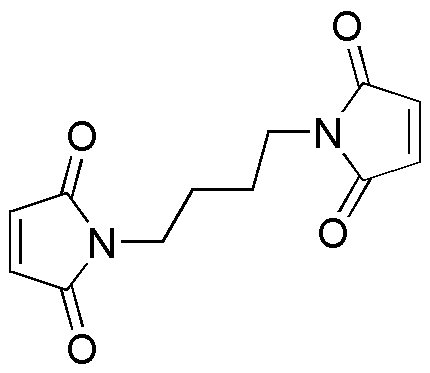1,4-Bis-maleimidobutane is widely utilized in research focused on:
- Bioconjugation: This compound is essential for linking proteins and other biomolecules, enhancing the development of targeted therapies in pharmaceuticals.
- Polymer Chemistry: It serves as a crosslinking agent in the synthesis of hydrogels and elastomers, improving the mechanical properties of materials used in medical devices.
- Diagnostics: Utilized in the creation of biosensors, it helps in the detection of specific biomolecules, which is crucial for early disease diagnosis.
- Vaccine Development: The compound plays a role in the formulation of vaccine adjuvants, boosting immune responses and improving vaccine efficacy.
- Material Science: It is used in the production of advanced composite materials, offering enhanced durability and performance in various industrial applications.
General Information
Properties
Safety and Regulations
Applications
1,4-Bis-maleimidobutane is widely utilized in research focused on:
- Bioconjugation: This compound is essential for linking proteins and other biomolecules, enhancing the development of targeted therapies in pharmaceuticals.
- Polymer Chemistry: It serves as a crosslinking agent in the synthesis of hydrogels and elastomers, improving the mechanical properties of materials used in medical devices.
- Diagnostics: Utilized in the creation of biosensors, it helps in the detection of specific biomolecules, which is crucial for early disease diagnosis.
- Vaccine Development: The compound plays a role in the formulation of vaccine adjuvants, boosting immune responses and improving vaccine efficacy.
- Material Science: It is used in the production of advanced composite materials, offering enhanced durability and performance in various industrial applications.
Documents
Safety Data Sheets (SDS)
The SDS provides comprehensive safety information on handling, storage, and disposal of the product.
Product Specification (PS)
The PS provides a comprehensive breakdown of the product’s properties, including chemical composition, physical state, purity, and storage requirements. It also details acceptable quality ranges and the product's intended applications.
Certificates of Analysis (COA)
Search for Certificates of Analysis (COA) by entering the products Lot Number. Lot and Batch Numbers can be found on a product’s label following the words ‘Lot’ or ‘Batch’.
*Catalog Number
*Lot Number
Certificates Of Origin (COO)
This COO confirms the country where the product was manufactured, and also details the materials and components used in it and whether it is derived from natural, synthetic, or other specific sources. This certificate may be required for customs, trade, and regulatory compliance.
*Catalog Number
*Lot Number
Safety Data Sheets (SDS)
The SDS provides comprehensive safety information on handling, storage, and disposal of the product.
DownloadProduct Specification (PS)
The PS provides a comprehensive breakdown of the product’s properties, including chemical composition, physical state, purity, and storage requirements. It also details acceptable quality ranges and the product's intended applications.
DownloadCertificates of Analysis (COA)
Search for Certificates of Analysis (COA) by entering the products Lot Number. Lot and Batch Numbers can be found on a product’s label following the words ‘Lot’ or ‘Batch’.
*Catalog Number
*Lot Number
Certificates Of Origin (COO)
This COO confirms the country where the product was manufactured, and also details the materials and components used in it and whether it is derived from natural, synthetic, or other specific sources. This certificate may be required for customs, trade, and regulatory compliance.


